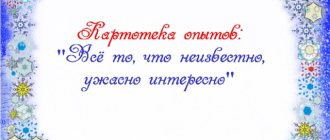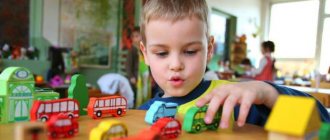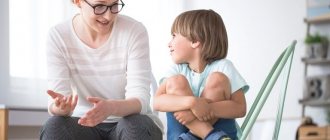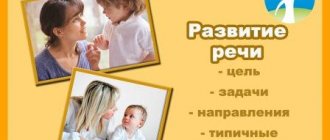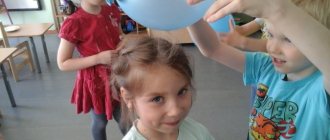MAGAZINE Preschooler.RF
From the experience of a senior teacherAuthor: Elena Borisovna Chumanova, senior teacher at the Children's Development Center - Kindergarten No. 17, Syktyvkar.
Joint projects of teachers and educators Design project “Theater and Children” .
Description.
Objective of the project:
Creating optimal conditions for the development of theatrical activities through the organization of creative, productive, artistic and aesthetic activities.
Performers: teachers and parents of secondary group No. 7
Tasks:
Children:
- Teaching children the ability to plan and set goals.
- To develop the ability to use the most rational ways to achieve results, to help solve assigned problems.
- Form creative imagination and fantasy.
Parents:
- Create favorable conditions in the family for the development of the child, taking into account the experience acquired by children in kindergarten.
- Increasing parents' self-esteem.
- Involve parents in modernizing the subject-development environment.
Teachers:
1. Development of pedagogical competence in mastering the technology of project activities together with parents.
Expected result:
- To develop the interest of children and parents in creative activities.
- Create different centers to enrich the subject-development environment in theater groups.
- Hold a “Theater Week” .
Project participants:
- teachers of 1st and 2nd junior, middle, senior, preparatory groups
- children of older, preparatory groups
- parents
Project duration:
- long-term.
Project implementation:
The joint project, carried out together with teachers, parents and children, took place in 3 stages:
- An indicative and motivational stage, during which children were introduced to the world of theatrical activity, interest was stimulated, they were told about the need for the obligatory presence of different costumes, masks, different types of theaters, and awareness of the purpose of theatrical activity. Parents discussed the progress of the project, found out possibilities, means, identified tasks that would be solved together with the children, and determined the expected result.
- Operational stage:
A). Conversations were held with the children, “What is theater” , “What are costumes” , “How to behave in the theater” , “Who plays in the theater?” , “Who are the actors? ”
b). teachers organized thematic centers for children:
- — creating costume models based on your favorite fairy tales
- - papier-mâché animal figurines for the fairy tales “Kolobok” , “Turnip” and other fairy tales
- — drawing animal figures for table theaters, shadow theater, flannelgraph
- - cutting out the outlines of animal figures, cutting out the outlines of masks for different types of theater
V). with parents were carried out:
- consultations on organizing different types of theaters in preschool educational institutions
- selection of practical material for studying varieties of theaters
- master class on making papier-mâché figures
- making masks
- making finger theater (knitting figures, sewing from fabric)
- production of theater dolls and marionettes.
3. Final stage:
- project defense - presentation.
Providing children and parents with the opportunity to demonstrate the results of joint creativity in “Theater Week” .
Making a photo album.
| Next > |
Pedagogical experience of a preschool teacher. Increasing cognitive activity of preschool children
Generalization of pedagogical experience on the topic: “Increasing the cognitive activity of children through creative tasks”
Children are inquisitive researchers of the world around them. This feature is inherent in them from birth. Formation of cognitive activity in preschoolers is one of the most important tasks of teaching a child in kindergarten. Cognitive activity is a socially significant personality quality and is formed in preschoolers in various types of activities. Cognitive activity is formed mainly in cognitive activity, which is associated with the child’s purposeful actions and includes not only the process of purposeful learning led by the teacher, but also the child’s independent, often spontaneous acquisition of certain knowledge. It is known that knowledge obtained in this way is fuzzy, incomplete, insufficiently conscious, sometimes distortedly reflecting reality, but the child’s activity in obtaining and acquiring it is much higher than the process led by the teacher. The child’s activity in the process of organized activities, as a rule, is programmed by the teacher, but in our practice we use the well-known postulate: the child happily learns and explores what is of interest to him. The cognitive activity of a preschooler is manifested, first of all, in the child’s ability to accept from an adult and independently set a cognitive task. The process of cognitive activity is determined not by external (motor) activity, not by the degree of employment of the child, but mainly by the level of internal (mental) activity, which carries elements of creativity. Motivation plays a big role in our practical activities. In the educational process it is necessary to use situational and internal motivation. Situational motivation is interest in a specific activity, in certain cognitive material. The child does not want to be active in uninteresting activities, or to act under compulsion, which only causes him negative experiences. But at the same time, a child can be active for a long time, if he is interested, he is surprised. Situational motivation also includes interaction with the teacher himself. If a child likes a teacher, his classes are always interesting - this also increases the cognitive activity of preschoolers. Internal motivation is an opportunity to develop individual abilities during a child’s stay in a preschool educational institution. When implementing this aspect, it is necessary to rely on the specific cognitive abilities of each child and create for him an individual development trajectory, which is created with the participation of all preschool specialists (teachers, psychologists, medical personnel). Thus , in organizing cognitive activity, it becomes possible to take into account the interests and needs of each child. For children with high cognitive abilities, we create conditions for the development and deepening of knowledge. For children with average and low cognitive activity we use individual and additional work. With this approach, preschool teachers have the opportunity for more differentiated work with each category of children. In addition, this approach helps to reduce the teaching load, because The average approach to all children is eliminated, and most importantly, the child’s activity during cognitive activity increases. The child’s cognitive interest is reflected in his games, drawings, stories, and various types of creative activities. Adults must provide conditions for the development of such activities. I would like to present some creative tasks to increase cognitive activity. Familiarization with fiction. One of the methods for developing thinking, imagination and speech is to combine two short stories or fairy tales into one with a new plot. We must immediately make a reservation that this is not an easy job for us adults either. In this case, both the child’s speech and imagination play an active role. In this work, undoubtedly, adults are the leaders and organizers. You can also invent with children and you need to do this in a variety of ways: • invent old objects in new versions; • transform yourself and your family members and friends into other animate and sometimes inanimate objects; • make up fantastic tales about yourself. • theatrical performances staged with the participation of children based on the plots of stories and fairy tales; • “twisting” of a fairy tale. You can invite children to remember a famous fairy tale and tell it in a new way. For example, add a new character, introduce new information; • “salad from fairy tales.” Children are invited to combine heroes from various works in a new fairy tale. For example, three bears, a wolf and seven kids, Little Red Riding Hood, and describe their adventures in the forest. One of the methods for developing cognitive activity is to pose a problematic question.
Exploratory questions are very useful. Why? For what? How? I will give examples of problem situations I used: Getting to know the outside world.
Ecology. Game "What happens if?" The good thing about the game is that it can be played anywhere: at home, on a walk, in transport.
This is a thinking game on a variety of topics. All answer options are accepted. Try to expand the topic to the limit by asking your child leading questions. Examples of tasks: What will happen if... ... a person stops eating? ...can't turn off the boiling kettle? ... leave the refrigerator open? ... wear tight shoes? ...not brushing your teeth? ... hit the ball through the window? ...eat ten scoops of ice cream at once? ...teasing the neighbor's dog? ...walk backwards? ...not sleep? ... plant flowers in the sand? ... sit on a hedgehog? ... will a person learn to fly? ... You went into the forest and got lost, it’s already getting dark, and you can’t find your way home? — With the onset of autumn, some birds fly away to warmer regions, and some remain. Why? — How did the bread “arrive” on the table? — Why can’t inedible mushrooms be destroyed? - If there was no water, air, sun. What would happen then? And so on. Mathematics
— How do you know that there are more of some items than others? How to equalize sets? — How can you get 6 apples on a plate if there are only 5 of them so far? — How many sticks do you need to take to “build” a house for a fairy-tale hero? — For physical education, you need to build according to your height. How to do it? — How to determine the equality of the sides of squares? (make a measurement). — The teacher asked Dasha to go to the nurse. Explain to the girl where she needs to go (spatial orientation). — Mom asked me to set the table for tea. How many devices need to be installed? And so on.
Fine art, manual labor, design.
— When drawing an illustration for a fairy tale, you need to show that its main character is a bunny. What needs to be done so that everyone understands who the main character of the fairy tale is? — For the applique you need to prepare several parts of the same shape. How to do this quickly and accurately? — To depict an aquarium with fish, the child receives a square of blue paper. What pencils should you choose so that the fish don’t get lost in the “water”? — When sculpting a dog in front of a child, there is a problem: how to show that the dog offers its paw, barks, and runs. — When designing buildings, you can invite children to decorate the surrounding area. — It is necessary to “build” a bridge of such a design that a ship can sail under it. — Draw leaves in summer, autumn, spring, etc.
Fiction, speech development
— After reading the work, invite you to think about what you would do in the place of the literary character. - Offer to come up with your own ending to the fairy tale. — Invite children to “become” an illustrator, but draw the illustration with words. — Offer to become a poet and come up with rhymes for a poem. - Offer to carefully examine the picture, remember and tell your younger brother from memory what you saw. - Suggest asking parents if they know this literary work and what it is about. — How to read a poem so that the audience understands what the author wanted to convey. Problem situations for preschoolers can be created not only on subject educational material. Cultivating resourcefulness, constructiveness, and flexibility of thinking is successfully achieved when solving everyday or situational problems. For example, you can use the following:
Transport situations.
— You and your parents are traveling on the bus. They got off, but you didn’t have time. What will you do? Why? — Your parents got on the train, and you stayed behind. What will you do? Why?
Fire situations.
— There is a fire in the apartment. What will you do? — Smoke in the apartment. Your actions.
Water situations
- You see someone drowning.
What will you do? — A faucet burst in the apartment. Are you alone at home now. What will you do first, what will you do next? Another method is research.
These include: observation, experiment, experience. Observation
To develop observation and attention, you can carry out the following exercises:
“Magic bag” (I put various objects, familiar toys in a bag, I suggest naming them from memory, I use a competition: who can remember the most) “Find the differences” (there is a set of paired pictures) “Find the pairs " (tasks include searching for pairs of shoes, gloves, identical geometric shapes) "What did the artist draw incorrectly?" (drawings with errors), etc. Observation of seasonal changes in nature, recording in the nature calendar . Observing the stages of plant development. Organize observations while walking (seasonal changes in living and inanimate nature, human labor, weather phenomena, animal life);
in a living corner (development of indoor plants, vegetable garden on the window), the work of people of different professions (excursions). Experiment
The most important research method is experiment.
Experiments can be mental or real. From mental ones you can use, for example, the following type: -What can be made from a piece of paper? -What will happen if everyone grows taller? -What animal does the darkening cloud look like? Etc. But the most interesting experiments are real experiments with real objects and their properties. You can conduct the following experiments with children: 1. Our senses
: with their eyes closed, children identify objects by touch, smell, taste, etc.
2. Properties of water
: transparency, taste, smell, three physical states, fluidity, etc.
3. Properties of sand and clay. 4. Mixing paints, obtaining new colors and shades. 5. Properties of paper, its types. 6. Alone or together
(offer to compare the quality and speed of cleaning of one person or group of children)
7. The ability to control oneself
(ways to improve the mood of oneself and others).
To increase cognitive activity, you can also use the following types of tasks: “Joint drawing”, “Come up with a fairy tale”, “Come up with a name”, “Tender steps” (as you take a step, we say a kind word to your friend), “Magic chair” (who sits on a magic chair everyone says compliments), “My funny portrait”, “Guess who I am?” (elements of pantomime), “The Life of Things” (we compose stories about things), “We compose fables” (about fairy-tale characters) and many others. When playing games, be sure to use a positive assessment, which contributes to the formation of sustainable interest in any type of activity.
We recommend watching:
The leading activity in a preschool educational institution is the game. How to develop logical thinking in preschoolers. Content and forms of interaction between the preschool educational institution and the family on the development of speech in older preschoolers. Information and analytical report on the results of thematic control in kindergarten.
Similar articles:
How to organize the educational process in a preschool educational institution
Development of creative abilities of preschool children in theatrical activities
Emotional development of a senior preschooler
Pedagogical terms for educators
How to assess a child's mental abilities
The role of the teacher in the cognitive activity of preschool children
The role of the teacher in the cognitive activity of preschool children
Kamyshova Tatyana Valerievna, teacher;
Kostina Svetlana Borisovna, teacher
MDOU kindergarten No. 98 “Ivushka”, Volzhsky, Volgograd region
The role of the teacher in the development of cognitive activity of preschool children.
Key words: project method, cognitive activity of children, research activity, productive activity, role of the teacher, form of organization of educational work, teacher competence.
The question of the development of cognitive activity of preschool children in the theory and practice of pedagogy is especially relevant. Modern pedagogical research shows that the main problem of preschool education is the loss of liveliness and attractiveness of the learning process. How to improve the situation? The formation of a new education system requires significant changes in the pedagogical theory and practice of preschool institutions, and the improvement of pedagogical technologies.
Cognitive activity is the active activity of acquiring and using knowledge.
The development of cognitive activity is a purposeful pedagogical process of complex interaction between the individual and the environment in order to resolve the inherent need for an adequate reflection of objective reality by the subject of cognition [1, p.24].
In the process of cognitive activity, the child’s cognitive development occurs.
Cognitive activity is always based on a problem, so its goal is determined by solving the difficulties that have arisen.
The main principle of organizing the cognitive activity of preschool children is the principle of awareness and activity in the process of acquiring knowledge.
The main task of a child’s cognitive development is the formation of the need and ability to think actively and overcome difficulties in solving various mental problems.
A number of studies by domestic and foreign authors show the possibility and effectiveness of using various problematic tasks in teaching preschoolers, which are characterized by the presence of difficulties associated with the fact that subjects do not have ready-made solutions, and they are forced to look for them (Z. A. Gracheva, I. K Postnikova, T. A. Kulikova, K. Yaro, R. Perlay, etc.). The task can be complex, it has many actions, the final result is significantly removed from the initial stage of the solution. And, conversely, a very simple task can present a certain difficulty; if the method of solving it is unknown, then you need to look for it. The difficulty (not complexity) that a person overcomes in the process of finding solutions is an important distinguishing feature of a problematic task [2].
The formation of cognitive activity of preschoolers requires the teacher to demonstrate a creative approach to organizing the educational process.
The creative potential of a teacher is characterized by a number of personality traits, which are called signs of a creative personality:
— the ability to notice and formulate alternatives, question the obvious at first glance, and avoid superficial formulations;
- the ability to delve into a problem and at the same time break away from reality and see the future;
- the ability to present a familiar object from a completely new perspective, in a new context;
- the ability to associate (quick and free switching of thoughts, the ability to evoke images in the mind and create new combinations from them);
- memory readiness (mastery of a sufficiently large volume of systematized knowledge, orderliness and dynamism of knowledge) and the ability to generalize;
— creativity, that is, the ability to transform the activity being performed into a creative process [4, p. 47].
The use of innovative pedagogical technologies opens up new opportunities for the education and training of preschoolers, and the project method has become one of the most effective today. Design technology relates to modern humanitarian technologies, which are innovative in the work of preschool institutions. The project method is interesting and useful not only for children, but for teachers themselves. It makes it possible to concentrate material on a specific topic, increase the level of one’s own competence on a problem, bring relationships with parents to a new level, feel like one is truly a partner with children in solving research problems, and make the learning process not boring and overly edifying.
Let's look at the features of organizing the project method as an option for the cognitive activity of preschool children:
— the method is based on the child’s active cognitive activity;
— the starting point of the child’s cognitive activity within the project;
- children's interests;
— the content of the project reflects various aspects of a child’s life and includes the main types of children’s activities;
- children themselves determine and implement cognitive tasks;
— the cognitive activity of children is of a clearly productive nature, the event (display of costumes sewn together with parents) is the final stage of the project.
Types of projects in preschool educational institutions (creative, gaming, practice-oriented, information and research).
In any of the above types of projects, there are necessarily components of the game: plot-role-playing, theatrical, didactic, plot-didactic, moving, directing.
The most effective in terms of organizing the cognitive development of preschool children is an information and research project.
Structure and approximate content of information and research projects.
Goal: development in children of the main components of cognitive activity and the cognitive sphere (thinking, attention, memory, imagination) and obtaining information in accordance with the problem posed.
Tasks:
1. Development of children's needs for new knowledge (based on the specifics of the problem).
2. Formation of conscious use of the experience of others and one’s own (in a certain area of knowledge).
3. Formation of cognitive skills in children.
4. Obtaining, deepening and systematizing ideas in a certain area.
Project participants are usually children, teachers and parents.
The organization of the project includes three main stages.
Stage 1. Statement of the problem, determination of the goals and objectives of the research work.
The research problem is identified based on the experiences of children, based on their interests and needs.
As an example, we can offer the following problem, the careless attitude of children towards clothes and the reason for this: for one month in kindergarten they studied where the material comes from, what it is, where, who and how sews clothes. The children, with the help of the teacher and parents, learned how much work is needed to make clothes. We organized exhibitions of “I am a fashion designer” appliqués, made “Baby Books” with the help of parents, and the final event was a costume show. After a detailed study of the problem, the children began to pay attention to the properties of the material, and having learned how much work is put into each dress, shirt, etc., they began to be more careful and careful with their clothes.
The research hypothesis is put forward on the basis of a problem defined and well understood by the children in the process of joint discussion between the teacher and the children, conversations between children and parents, reading literature, excursions, and experimentation. It is finally formulated by the teacher in a version accessible to children’s understanding and discussed. For example, based on the problem discussed above, we can put forward the following hypothesis: clothing goes through a very long path of transformation. For example, linen: first the flax grows, then the threads are woven into fabric, then it is dyed, and only after this long process, the seamstress sews clothes from it. In accordance with the problem and hypothesis of the study, children, with the help of the teacher, set tasks for further research of the problem (study of features, properties, analysis of relationships, methods of use). At this stage of project organization, the results of the study are determined. Depending on the nature of the problem and objectives, the results may be:
- collection;
- an album (collection) of children's stories, riddles, poems, proverbs;
— an exhibition of drawings, applications and handicrafts by children on the theme of the project;
- games and aids invented and created by children.
Stage 2. Organization of research within the project.
At this stage, the organization of two main types of cognitive activity of children is assumed.
1. Collection and analysis of information.
2. Creative cognitive activity of children can be presented as the organization of joint with the teacher and independent didactic, plot-didactic, plot-role-playing, outdoor, theatrical games.
Stage 3. Presentation of the results of children's research activities. Each option for organizing the cognitive activity of preschool children can be independently developed by the teacher and filled with specific content depending on the characteristics of the educational program and program section. The main thing is to effectively use the possibilities of play in the cognitive development of your child. S. L. Rubinstein, based on specific ideas about the mechanisms of human development, formulated a number of provisions: for a child there is nothing more natural than to develop, form, become what he is in the process of upbringing and training.
The teacher is required to provide targeted, constant stimulation that promotes the preschooler’s need for cognition as a source of personal activity. The form of expression of internal needs for knowledge is cognitive interest.
Research shows that with the help of a teacher, preschoolers can successfully complete project activities. At the same time, there are clear positive changes in the cognitive development of children, personal growth of preschoolers is observed, which is expressed in the desire to perform original creative works. The interpersonal relationships of preschoolers change significantly, children gain experience of productive interaction, the ability to hear others and express their attitude to various aspects of reality.
A child, like an adult, is in a constant process of learning about the world; he thinks, analyzes, speaks, listens, understands, feels, and communicates with other people. In the process of communication with adults and peers, cognitive activity, intensive development of the child’s personality and cognitive activity occurs [5].
Consequently, the teacher must captivate, interest and develop the cognitive activity of the preschooler. And also have such personal qualities as a teacher, such as the desire for self-development, creativity, tact and tolerance in relationships with children and parents. Only a knowledgeable and loving teacher can form cognitive activity in preschoolers.
Literature:
- Veraksa N. E., Bulycheva A. I. Development of mental giftedness in preschool age // “Questions of Psychology” 2000. No. 7. P.24.
- Denisenkova N. S., Klopotova E. E. Features of cognitive activity of children of middle preschool age in a normal situation. A child in the normative space of culture. Regional scientific and practical conference dedicated to the 70th anniversary of the memory of L. S. Vygotsky. Moscow - Birsk, 2004. pp. 80-89.
- From birth to school. Basic general education program for preschool education / Ed. N. E. Veraksy, T. S. Komarova, M. A. Vasilyeva. M.: MOSAIC SYNTHESIS, 2010. - 304 p.
- Novopavlovskaya, Yu. A. The essence of cognitive activity and pedagogical guidance in the formation of cognitive interest in preschool children / Yu. A. Novopavlovskaya // Preschool pedagogy. - 2009. - No. 8. - P. 47.
- Litvinenko, S. V. Development of cognitive activity in the preschool period / S. V. Litvinenko // Journal of scientific and pedagogical information (Electronic resource). - 2010. - 4. - Access mode: https://www.paedagogia.ru/2010/41–04/208-litvinenko
- Game-based learning for children aged 5–7 years. Methodical recommendations / Ed. N.V. Ivanova. - M.: TC Sfera, 2008. — 112 s. (Appendix to the magazine “Preschool Educator”).
